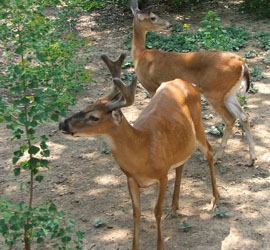Food Safety Risks from Wildlife
Chris Brunner, January 21, 2014
 The wildlife in our gardens and produce fields harbor the potential to carry pathogens and cause illness through ingestion of contaminated fresh produce. How significant is this food safety risk?
The wildlife in our gardens and produce fields harbor the potential to carry pathogens and cause illness through ingestion of contaminated fresh produce. How significant is this food safety risk?
Dr. Michele Jay-Russell, Program Manager for the Western Center for Food Safety and liaison to WIFSS has posed the question in a manuscript in CAB Reviews, “What is the risk from wild animals in food-borne pathogen contamination of plants?” The manuscript focuses on potential produce food safety risks from wild animals at the pre-harvest level, and downstream processes that may promote pathogen survival and amplification that could lead to human food-borne illnesses, outbreaks, and recalls. Jay-Russell addresses the modern-day public health conundrum wherein consumers are encouraged to eat more fresh produce to help prevent chronic health problems, but at the same time consumption of contaminated produce can lead to potentially life-threatening acute food-borne disease.
Stories in the news of deer droppings that were the source of E. coli contamination in strawberry fields; deer intrusion in an apple orchard that was a possible contributing factor in a multi-state E. coli outrbreak; fecal material from a large population of sandhill cranes feeding in a pea field that was linked to a campylobacteriosis outbreak; and the spinach outbreak of 2006 that was traced to baby spinach grown on a ranch where a large population of feral pigs shared pasture with a grass-fed cattle herd, serve to illustrate the potential for wildlife to carry pathogens and cause illness.
How much poop in the field does it take to cause a serious human health risk?
Jay-Russell describes the small levels of contamination that may represent serious risks. For example, even a small level of animal droppings with a low infectious dose of E. coli O157:H7 and other foodborne pathogens in a field may later amplify into a more serious problem as a result of downstream failures during, processing, transport, handling, and storage of raw produce.
Is fencing or the removal of water bodies the answer?
Good agricultural practices, or GAPs, developed and implemented by the produce industry and FDA to address all of the known potential sources of contamination at the farm and harvesting levels are not without their challenges. The voluntary GAPs program has led to potential conflicts with conservation and water quality programs.
Jay-Russell discusses the challenge of balancing food safety and environmental stewardship and the concept of co-management which has emerged from the food safety, agriculture, and conservation communities to address these challenges. This successful collaboration is a positive step forward in managing food safety risks from wildlife.
The bottom line is informing consumers what they can do to practice food safety and enjoy nutritious fresh fruits and vegetables. In the Food Safety article Jay-Russell outlines seven steps consumers can take with their fresh produce to prevent foodborne illness.
Stay tuned for more from Jay-Russell in late July when she gives her highlighted-speaker remarks in Denver at the 2014 AVMA Annual Convention and talks about “The Wildlife-Livestock Interface in Produce Food Safety.”
Read more about the potential source of fresh produce contamination from wild animals in Jay-Russell’s 2011 Food Safety News article, “Ferel in the Field: Food Safety Risks from Wildlife.”
